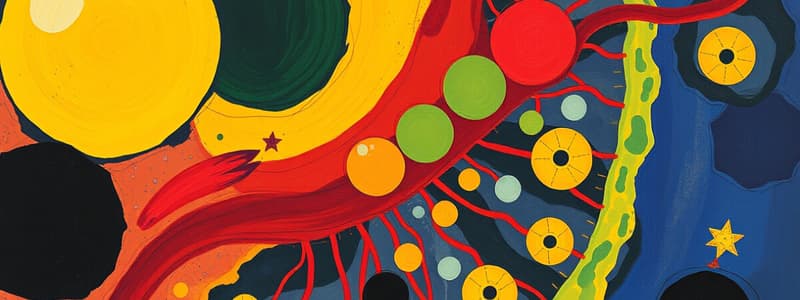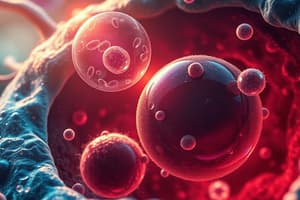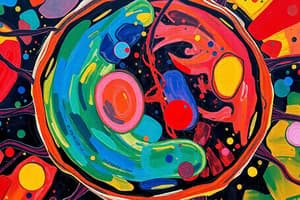Podcast
Questions and Answers
What is the primary function of mitochondria?
What is the primary function of mitochondria?
- Production of ATP (correct)
- Detoxification of harmful substances
- Storage of nutrients
- Synthesis of proteins
What is the primary role of the rough endoplasmic reticulum?
What is the primary role of the rough endoplasmic reticulum?
- Degradation of waste materials
- Synthesis of lipids
- Modification of nucleic acids
- Synthesis of proteins (correct)
What is the relationship between ribosomes and the rough endoplasmic reticulum?
What is the relationship between ribosomes and the rough endoplasmic reticulum?
- Ribosomes on the RER synthesize proteins that enter the RER's lumen (correct)
- Ribosomes on the RER synthesize proteins for mitochondria
- Ribosomes remodel RER membranes
- Ribosomes store proteins within the RER
Which component is NOT part of a ribosome's structure?
Which component is NOT part of a ribosome's structure?
What type of ribosomes synthesizes proteins that function within the cytosol?
What type of ribosomes synthesizes proteins that function within the cytosol?
What is THE FUNCTION of mitochondria?
What is THE FUNCTION of mitochondria?
Flashcards are hidden until you start studying
Study Notes
Mitochondria and Energy Production
- Function: Powerhouse of the cell; site of ATP (adenosine triphosphate) production.
- Structure: Double membrane (outer and inner membrane); inner membrane forms folds called cristae.
- Processes:
- Cellular Respiration: Converts biochemical energy from nutrients into ATP.
- Krebs Cycle: Takes place in the mitochondrial matrix; generates electron carriers (NADH, FADH2).
- Electron Transport Chain: Located in the inner membrane; uses electrons from NADH and FADH2 to create a proton gradient, driving ATP synthesis.
Vesicle Transport Mechanisms
- Definition: Vesicles are small membrane-bound sacs that transport molecules within cells.
- Types of Vesicular Transport:
- Endocytosis: Process of taking material into the cell by engulfing it in a vesicle.
- Types: Phagocytosis (cell eating), Pinocytosis (cell drinking), Receptor-mediated endocytosis.
- Exocytosis: Process of releasing materials from the cell through vesicle fusion with the plasma membrane.
- Endocytosis: Process of taking material into the cell by engulfing it in a vesicle.
- Role in Cellular Processes:
- Transport of proteins, lipids, and neurotransmitters.
- Maintenance of cellular homeostasis and communication.
Rough Endoplasmic Reticulum and Protein Synthesis
- Structure: Network of membranes studded with ribosomes, giving it a "rough" appearance.
- Functions:
- Synthesis of proteins destined for secretion, incorporation into the cell membrane, or lysosomes.
- Modification of polypeptides (folding, addition of carbohydrate groups).
- Relationship with Ribosomes: Ribosomes on the RER translate mRNA into polypeptide chains, which enter the lumen of the RER for processing.
Ribosome Structure and Function
- Structure: Composed of ribosomal RNA (rRNA) and proteins; consists of two subunits (large and small).
- Types of Ribosomes:
- Free Ribosomes: Float in cytoplasm; synthesize proteins that function within the cytosol.
- Bound Ribosomes: Attached to the rough ER; synthesize proteins for secretion or membrane insertion.
- Function: Sites of protein synthesis; facilitate the translation of mRNA into polypeptide chains through tRNA binding.
Mitochondria and Energy Production
- Mitochondria are known as the powerhouse of the cell, responsible for generating ATP, the main energy currency of cells.
- They possess a double membrane structure, consisting of an outer membrane and a highly folded inner membrane, which contains structures called cristae.
- The process of cellular respiration occurs within mitochondria, converting substrates derived from nutrients into usable energy (ATP).
- The Krebs Cycle occurs in the mitochondrial matrix, producing crucial electron carriers like NADH and FADH2, vital for energy transfer.
- The Electron Transport Chain (ETC) resides in the inner membrane; it harnesses electrons from NADH and FADH2 to establish a proton gradient, facilitating ATP synthesis via chemiosmosis.
Vesicle Transport Mechanisms
- Vesicles are tiny membrane-enclosed sacs that facilitate the transport of various molecules within cells.
- Endocytosis is a pivotal process allowing cells to internalize materials by enclosing them in a vesicle, including variants such as phagocytosis (cellular ingestion of large particles) and pinocytosis (cellular uptake of liquids).
- Receptor-mediated endocytosis allows selective uptake by binding specific molecules to receptors on the cell's surface.
- Exocytosis is essential for expelling materials from the cell by merging vesicles with the plasma membrane, thereby releasing contents into the external environment.
- Vesicular transport plays a crucial role in moving proteins, lipids, and neurotransmitters, contributing to cellular homeostasis and intercellular communication.
Rough Endoplasmic Reticulum and Protein Synthesis
- The rough endoplasmic reticulum (RER) is characterized by a network of membranes adorned with ribosomes, imparting a rough texture.
- It is primarily involved in synthesizing proteins which may be secreted from the cell, incorporated into cellular membranes, or directed to lysosomes.
- Proteins synthesized in the RER undergo modifications such as folding and the addition of carbohydrate chains before being transported to their final destinations.
- Ribosomes on the RER translate mRNA, which is essential for forming polypeptide chains that are processed within the RER's lumen.
Ribosome Structure and Function
- Ribosomes are made up of ribosomal RNA (rRNA) and proteins and exist as two distinct subunits: a larger subunit and a smaller subunit.
- Free ribosomes are dispersed in the cytoplasm and produce proteins that function directly within the cytosol.
- Bound ribosomes are attached to the rough ER and synthesize proteins that are either secreted from the cell or integrated into membranes.
- Ribosomes serve as the sites of protein synthesis, where they facilitate the translation of messenger RNA (mRNA) into polypeptide chains through the interaction with transfer RNA (tRNA).
Studying That Suits You
Use AI to generate personalized quizzes and flashcards to suit your learning preferences.




